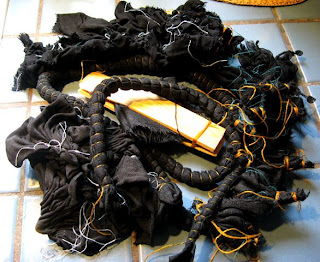- learn a few handstitched shibori techniques
- use black fabrics and discharge rather than dye the samples
- compare different fabrics so I'd know which ones would be worth exploring further and which to drop from consideration for future projects
 So here are the stitched, bound, and/or folded samples, which I prepared over the last 10 days or so.
So here are the stitched, bound, and/or folded samples, which I prepared over the last 10 days or so.  Sample 1, above: Ori-nui Shibori (undulating lines) on black rayon that used to be a CP Shades top that I hadn't worn in 7 or 8 years.
Sample 1, above: Ori-nui Shibori (undulating lines) on black rayon that used to be a CP Shades top that I hadn't worn in 7 or 8 years.
 Sample 2, above: Hinode Shibori (sunrise pattern) on black raw silk.
Sample 2, above: Hinode Shibori (sunrise pattern) on black raw silk.
 Sample 3, above: Midori Shibori (willow leaf) on black raw silk.
Sample 3, above: Midori Shibori (willow leaf) on black raw silk.
 Sample 4, above: Arashi Shibori (wind driven rain) on black raw silk, hand gathered rather than pole wrapped.
Sample 4, above: Arashi Shibori (wind driven rain) on black raw silk, hand gathered rather than pole wrapped.
 Sample 5, above: Kumo Shibori (spiderweb) on black silk gauze.
Sample 5, above: Kumo Shibori (spiderweb) on black silk gauze.
 Sample 6, above: Black silk gauze folded into a very small triangle, bound with two medium binder clips.
Sample 6, above: Black silk gauze folded into a very small triangle, bound with two medium binder clips.
 Sample 7, above: Itajime Shibori (board clamping) on black linen/rayon.
Sample 7, above: Itajime Shibori (board clamping) on black linen/rayon.
 Sample 8, above: detail of Komasu Shibori (squares) on black linen/rayon.
Sample 8, above: detail of Komasu Shibori (squares) on black linen/rayon.
I also tied up two samples using black cotton gauze but they didn't discharge at all. And a piece of old black cotton jersey T-shirt didn't turn out great, although a different pattern, I'm sure, would have worked better on that fabric.
I immersion discharged with thiox, and some interesting things happened. Although the samples looked in the pot under the liquid like all the color had discharged out, when exposed to air, they oxidized and the colors got dark again. I did the entire process twice, and a bit more black came out but still the samples darkened after coming out of the pot. In this way it was much like dyeing with indigo -- thiox and soda ash are major components of the indigo process anyway -- when you lift your fiber, yarn or fabric out of the pot and it's a pale green, then it turns blue with oxidation.
I was surprised that the black raw silk didn't discharge more. I also found it very interesting that the areas that discharged most completely were ones that were inside the bindings, pleats or gathers, less exposed to the chemicals.
At any rate, I loved the process, glad I finally learned some shibori techniques, and have a ton of ideas to try out on my handwoven fabrics. So I'd say it was a great success!








0 comments:
Post a Comment